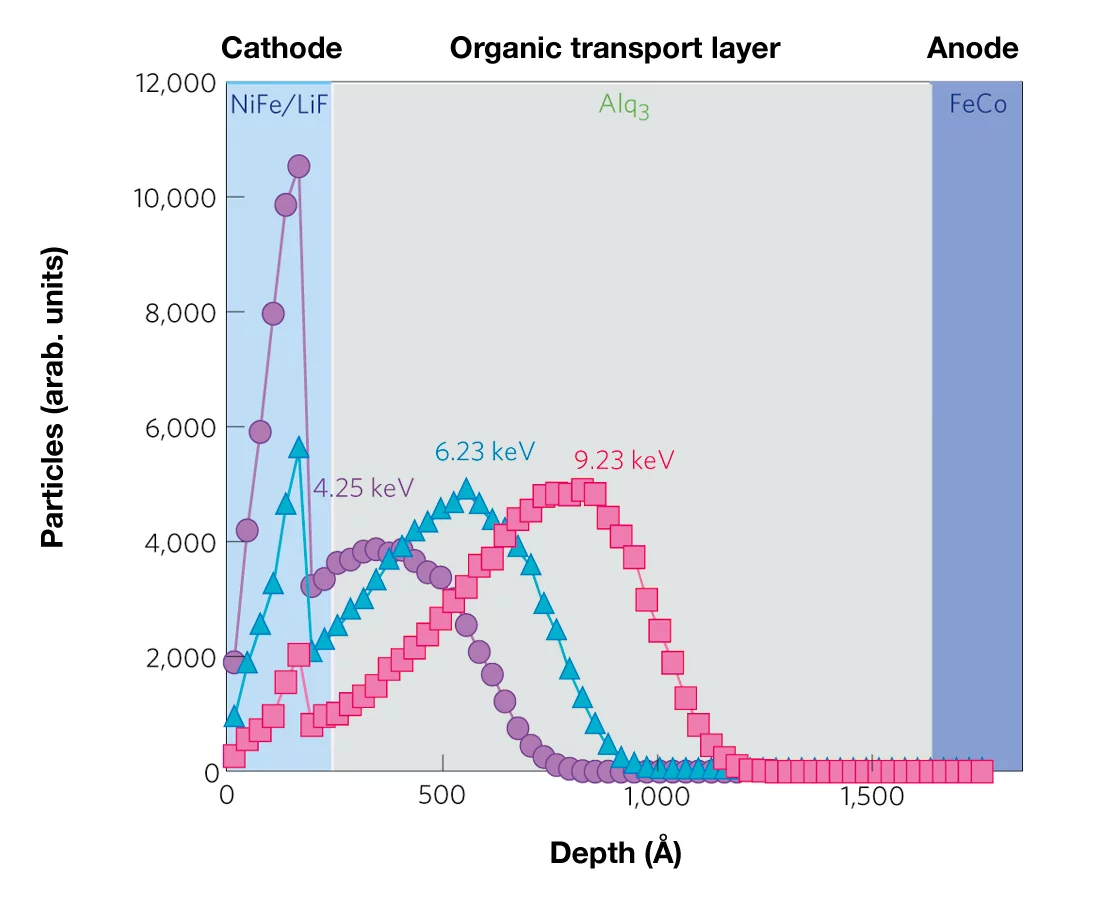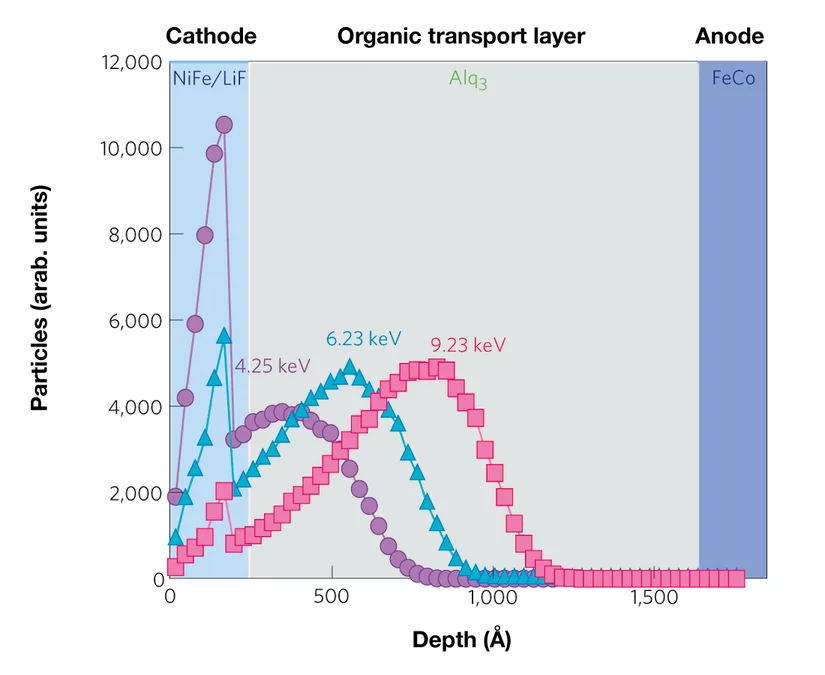Researchers from Queen Mary, University of London, the University of Fribourg and the Paul Scherrer Institut (Villigen, Switzerland) have shown that a magnetically polarised current can be manipulated by electric fields. Published in the journal Nature Materials, this important discovery opens up the prospect of simultaneously processing and storing data on electrons held in the molecular structure of computer chips – combining computer memory and processing power on the same chip. This may allow for the development of new devices with high power efficiency and reduced weight.
In the experiment, low-energy muons were “shot” into the sample. Each curve shows the number of muons that reached a particular depth. The different cures correspond to different energies of the incoming muons.
In one of the samples investigated, a thin (1 nm) LiF layer separated the NiFe cathode from the organic semiconductor Alq3. By varying the muon energy, scientists were able to determine the spin polarization as a function of the distance to the NiFe cathode, and thus show the inversion of the spin polarization in the presence of the LiF layer. Source: Nature Materials, DOI: 10.1038/nmat2912
The field of 'Spintronics' - spin transport electronics - has rapidly become the universally used technology for computer hard disks. Designed in thin layers of magnetic and non-magnetic materials, Giant Magnetoresistive (GMR) spin valves use the magnetic properties, or 'spin', of electrons to detect computer data stored in magnetic bits. In contrast, computer processing relies on streams of electrically charged electrons flowing around a tiny circuit etched into a microchip.
Devices with high power efficiency and reduced weight
"This is especially exciting, as this discovery has been made with flexible organic semiconductors, which are set to be the new generation of displays for mobile devices, TVs and computer monitors, and could offer a step-change in power efficiency and reduced weight of these devices," said Dr Alan Drew, from Queen Mary's School of Physics, who led the research. Dr Drew and his team have investigated how layers of Lithium Fluoride (LiF) - a material that has an intrinsic electric field – can modify the spin of electrons transported through these spin valves. He explains: "While in theory, devices that combine electron charge and spin is conceptually straightforward, this is the first time anybody has shown it is possible to proactively control spin with electric fields."
Method available only in Switzerland
Professor Christian Bernhard, from the University of Fribourg Physics Department, describes their successful technique: "Using the direct spectroscopic technique Low Energy Muon Spin Rotation (LE-μSR), our experiments have visualised the extracted spin polarisation close to buried interfaces of a spin valve." The experiments were performed at the Paul Scherrer Institute, the only institution in the world where this technique is available. The method employs the magnetic properties of muons – unstable subatomic particles. “In such an experiment muons are shot into the material and when they decay, the decay products carry information about the magnetic processes inside the material” explains Dr. Andreas Suter from PSI, where the experiment has been developed “The unique thing about low-energy muons is that they can be placed specifically in a particular layer of a multi-layer system. Thus, using this method one can study the magnetism in any single layer separately.”
About PSI
The Paul Scherrer Institute develops, builds and operates large-scale, complex research facilities, and makes these facilities available to the national and international research community. The Institute”s own research focuses on solid-state physics and the materials sciences, elementary particle physics, biology and medicine, as well as research involving energy and the environment. With a workforce of 1400 and an annual budget of about 300 million CHF, PSI is the largest research institution in Switzerland.
Kontakt / Ansprechpartner
Dr A J Drew, Molecular & Materials Physics, Physics Department,
Queen Mary, University of London, London, E1 4NS, UK,
Phone: +44 207 8827891, E-mail: A.J.Drew@qmul.ac.uk [English]
Prof. Dr. Christian Bernhard, Physics Department,
University of Fribourg, CH-1700 Fribourg, Switzerland,
Telefon: +41 26 300 90 70, E-mail: christian.bernhard@unifr.ch [German, English, French]
Dr. Thomas Prokscha, Laboratory for Muon Spin Spectroscopy,
Paul Scherrer Institut, 5232 Villigen PSI, Switzerland, Telefon: +41 56 310 42 75, E-mail: thomas.prokscha@psi.ch [Deutsch, Englisch]
Prof. Dr. Elvezio Morenzoni, Laboratory for Muon Spin Spectroscopy,
Paul Scherrer Institute, 5232 Villigen PSI, Switzerland,
Phone: +41 56 310 36 70, E-mail: elvezio.morenzoni@psi.ch [German, Italian, French, English]
Further Information
Original publication
Engineering spin propagation across a hybrid organic/inorganic interface using a polar layer
L. Schulz,L. Nuccio, M. Willis, P. Desai, P. Shakya, T. Kreouzis, V. K. Malik, C. Bernhard, F. L. Pratt, N. A. Morley, A. Suter, G. J. Nieuwenhuys, T. Prokscha, E. Morenzoni, W. P. Gillin & A. J. Drew
Nature Materials, Advance online publication (2010) DOI: 10.1038/nmat2912


